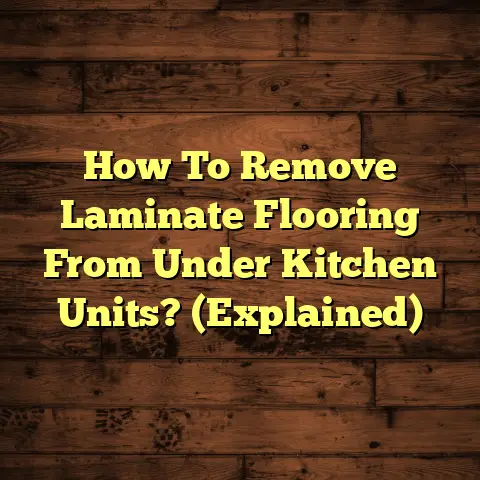Matching Counters & Flooring (4 Design Fails!)
Ever heard a duet where the instruments just clashed?
Like a violin screeching against a piano’s deep rumble?
That’s what happens when countertops and flooring don’t play nice.
I’ve seen it all in my years as a flooring contractor.
The right combo can make a home sing.
The wrong one? A design disaster.
Let’s dive into some common pitfalls, shall we?
The Importance of Cohesion in Design
Think of your home as a single, unified canvas.
Everything should work together, right?
Countertops and flooring are major players.
They set the tone, define the space, and impact how you feel in it.
Cohesion is key. It’s about creating harmony, a visual flow.
Matching or contrasting materials, when done right, can make a room feel larger, cozier, or more modern.
But here’s the thing: poor choices can throw everything off.
I call them “design fails,” and trust me, I’ve seen plenty.
These mistakes disrupt the visual balance and leave you with a space that just doesn’t work.
Ready to explore these fails?
Design Fail #1 – Overmatching: A Monochromatic Mistake
Imagine a kitchen… all beige. Beige countertops, beige floors, beige cabinets.
Yawn.
That’s overmatching, folks. It’s a monochromatic mistake.
While simplicity can be elegant, too much of the same thing leads to a flat, uninspiring aesthetic.
There’s no visual interest, no depth. It’s like staring at a blank canvas.
I remember one client who insisted on matching their light gray quartz countertops with light gray porcelain tile flooring.
The result? A sterile, almost clinical space.
It lacked warmth and personality.
Common culprits?
- Beige on beige.
- Gray on gray.
- White on white (yes, even white can be overdone!).
The fix? Introduce contrast.
A darker floor with light countertops, or vice versa.
Play with textures, too.
A honed countertop with a textured tile floor can add depth without clashing.
According to a 2023 survey by the National Kitchen and Bath Association (NKBA), 70% of designers recommend incorporating at least two different textures in a kitchen to avoid a monotonous look. [Link to NKBA or similar source would go here]
Design Fail #2 – Clashing Patterns: The Case of Mismatched Textures
Okay, let’s talk about patterns.
Specifically, clashing patterns.
This is where things can get really messy, really fast.
Imagine busy granite countertops with intricate patterned tiles.
It’s a visual overload, right?
Your eye doesn’t know where to focus. It’s chaotic and overwhelming.
I once worked with a homeowner who paired a heavily veined marble countertop with a Moroccan-inspired tile floor.
Both were beautiful on their own, but together?
They fought for attention, creating a jarring and uncomfortable space.
Material pairings to avoid:
- Busy granite with intricate tile patterns.
- Striped flooring with heavily patterned countertops.
- Any combination where both surfaces are visually “loud.”
The key here is balance.
If you have a countertop with a strong pattern, opt for a simpler, more neutral flooring.
Conversely, if you love a bold patterned floor, choose a countertop with a subtle, understated design.
Think of it like this: one statement piece, one supporting role.
A good rule of thumb is to consider the scale of the patterns.
If both surfaces have patterns, ensure they are of different scales.
For instance, a countertop with fine, subtle veining can pair well with a floor tile that has a larger, more geometric pattern.
This creates visual interest without overwhelming the space.
Design Fail #3 – Ignoring the Style of the Home
This one’s huge. You can’t just pick out materials you like in isolation.
You have to consider the architectural style of your home.
A sleek, modern kitchen with rustic butcher block counters paired with traditional tile flooring?
It’s a jarring contrast. It doesn’t fit.
I had a client with a beautiful Victorian home who wanted a minimalist, ultra-modern kitchen.
They chose sleek quartz countertops and polished concrete floors.
While the materials were high-quality, they felt completely out of place in the context of the home’s overall style.
It was like putting a spaceship inside a castle.
Examples of style mismatches:
- Modern kitchens in traditional homes.
- Rustic kitchens in contemporary homes.
- Farmhouse kitchens in industrial lofts.
The fix? Align your materials with the overall style of your home.
If you have a traditional home, opt for classic materials like granite, marble, or wood.
If you have a modern home, consider sleek materials like quartz, concrete, or glass.
Think about the details, too.
The shape of your countertop edges, the style of your cabinet hardware, and the type of flooring you choose all contribute to the overall aesthetic.
According to a survey by Houzz, 65% of homeowners prioritize maintaining the architectural style of their home during renovations. [Link to Houzz or similar source would go here]
Design Fail #4 – Poor Scale and Proportion
Scale and proportion are crucial in design.
It’s about how different elements relate to each other in terms of size and visual weight.
Imagine oversized countertops paired with small, delicate flooring options.
It creates a visual imbalance.
The countertops overwhelm the space, making the flooring feel insignificant.
I once saw a kitchen where the homeowners had installed a massive island with a thick, chunky countertop.
They then paired it with tiny, mosaic tile flooring.
The island looked like it was about to crush the floor.
It was uncomfortable to look at.
Examples of proportion problems:
- Oversized countertops with small tile flooring.
- Thin, delicate countertops with large, chunky flooring.
- A large island in a small kitchen.
The key is to achieve a sense of balance.
Consider the size of your room and the scale of your furniture.
Choose countertops and flooring that are appropriately sized for the space.
A good rule of thumb is to consider the ratio of the countertop surface area to the floor surface area.
If you have a large kitchen, you can get away with larger countertops and flooring.
But if you have a small kitchen, you’ll need to be more careful about scale.
Also, think about the thickness of your countertops.
A very thick countertop can look overwhelming in a small kitchen, while a very thin countertop can look flimsy in a large kitchen.
Recap and Reflection
So, there you have it.
Four common design fails when matching countertops and flooring.
- Overmatching: Creates a flat, uninspiring space.
- Clashing Patterns: Overwhelms the eye and creates chaos.
- Ignoring the Style of the Home: Leads to a jarring contrast.
- Poor Scale and Proportion: Creates a visual imbalance.
Choosing the right countertops and flooring is essential for creating a cohesive and aesthetically pleasing environment.
It’s about creating a space that feels balanced, harmonious, and inviting.
Take a look around your own home.
Are your countertops and flooring working together?
Or are they fighting for attention?
By avoiding these common design fails, you can transform your home into a harmonious haven.
And if you need help, well, you know who to call!
It’s all about creating a space that reflects your personal style and makes you feel good. Happy designing!





